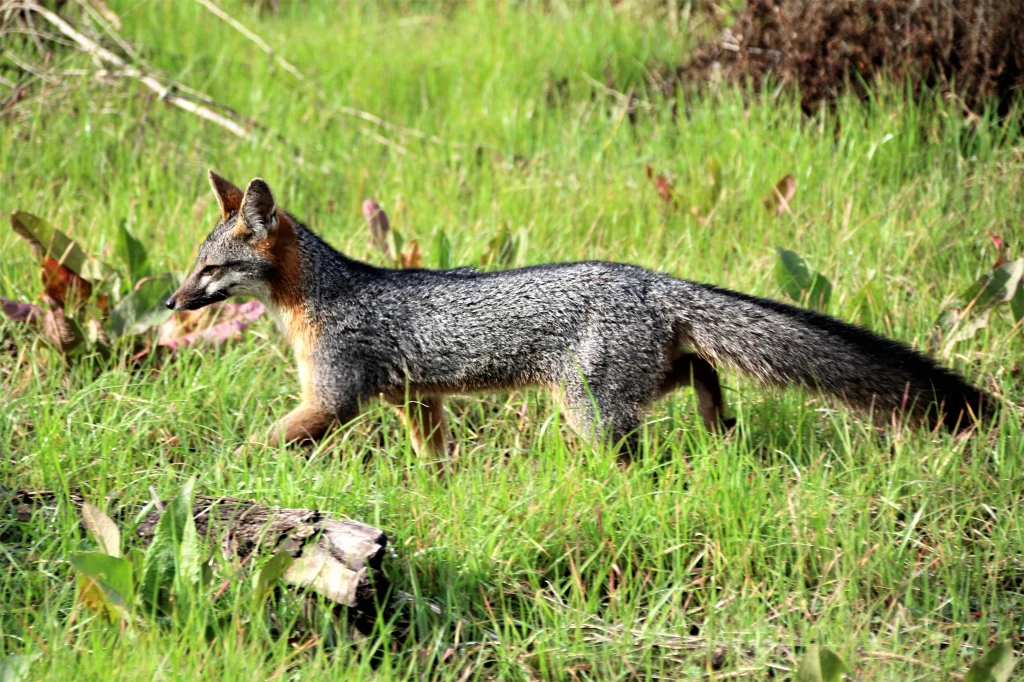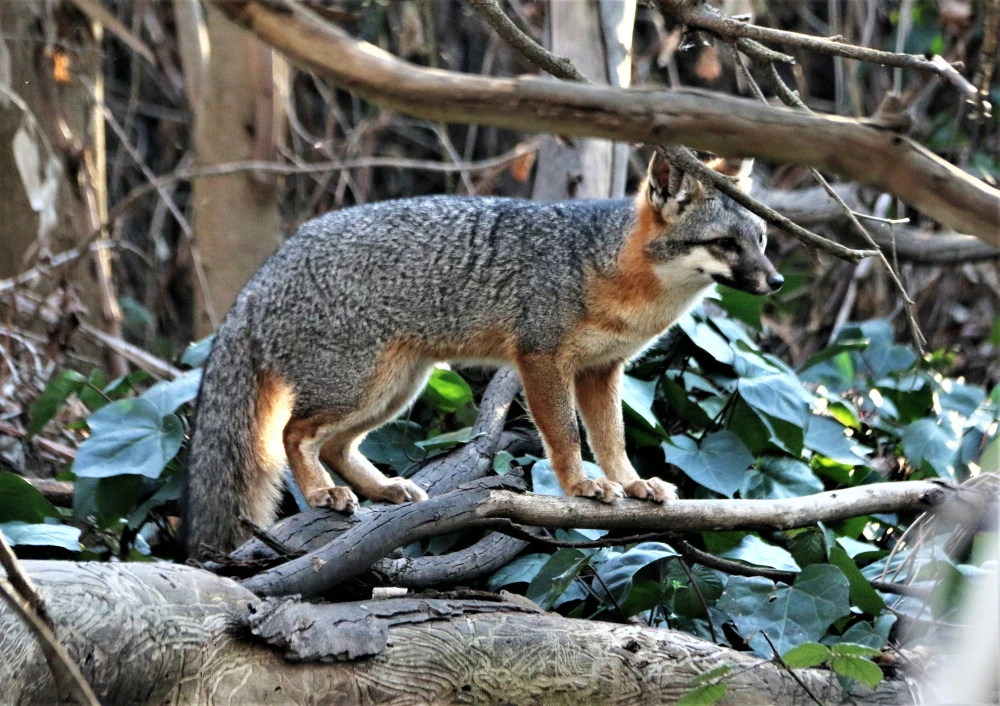A YEAR IN RETROSPECT 2021: EXCERPTS, OUR SLINGSHOT into 2022
by William C. Leikam
President, CEO & Co-founder, Urban Wildlife Research Project

TITLE
EXCERPTS
January
Bits & Pieces Along the Way
The Gray Fox Stretch: It struck me that every time one awoke, the very first order of wakeful business was to stretch. As I witnessed them stretching, it was obvious that the pattern was virtually the same in all fox families. On Changing Color: Within the community of gray foxes there are variations in color. In order to see these variations, one must be in the proximity of numerous gray foxes for a long time observing them day after day and over a year. Color & Camouflage: A Discussion: What does another animal that sees a tiger see? “The tiger is helped by the limited vision of their preferred prey. Deer and other hoofed animals can’t see the full range of colors, much like a colorblind human. (From The Conversation – Academic Rigor with Journalistic Flair https://theconversation.com/why-do-tigers-have-stripes-145223) Cold Nights & Gray Foxes: From the Gray Fox Log Tuesday, January 26, 2021 – Last night in several trail camera locations, especially camera numbers two and four located in the overflow channel, there were very few files on the SD Cards and sometimes no files at all such as at camera nine at the saltwater pipe near Fox Hollow.
FEBRUARY
Uses of and the Importance of Scat
In my walk/talk presentations at the Don Edwards San Francisco National Wildlife Refuge, when I’d first bring up the issue and importance of scat/poop, kids especially would go, “Ooaa, yucky.” However, once out on the trail and we began finding these smelly deposits, they began to understand and indeed they went the rest of the hour-long walk looking for scat, wanting to know more about it.
March
Time Change & A Log File
The foxes have shifted their time sense and so have we in that we changed our time by an hour forward. The two-time shifts have certainly made setting up the trail cameras and thus getting night shots a problem. STOLEN CAMERA – I saw that someone had stolen the camera and had broken the post. Whoever it was actually bent the post over, splitting the wood at the base and simply making a mess. They took all the straps that hold the camera in place as well.
April
Pups or Hormones?
That pair of gray foxes came into the woods along Matadero Creek on January 24, 2019. This pair has been here for two years. In that time, they have not had pups, but in 2020, at this time of year, she had become hugely skittish as she was this afternoon and on previous afternoons. So, given the present, is she acting so hyper-skittish because she has pups back in the thicket, or if she doesn’t have pups, is this response a hormonal shift that causes her to be so highly sensitive and therefore skittish? Might this apply to all gray fox females at this time of year?
MAY
Violent Head Shaking
As we monitor the gray fox pair and document their behavior, I am once again seeing something that has me perplexed and concerned. Laimos especially and most likely because I see him more often than Big Eyes, is once again violently shaking his head. When he does that, I can only think that whatever is in his ear(s) must be hugely irritating. And then to complicate the matter, I checked back into my previous Gray Fox Reports and in the June and July 2020 edition of this report, I also note that the foxes are shaking their heads. This appears to be seasonal for here we are in June 2021. This does not happen during the remainder of the year.
JUNE
Head Shaking & Injuries
I am once again seeing that Laimos continues to violently shake his head. Dr. Chad Alves said that there’s probably something stuck in his ear, but I wonder because it seems to be going on for far too long. I say that only because, as I’ve mentioned before, gray fox pairs have an ear cleaning ritual that they perform on one another.
JULY
Laimos Decides
“I swapped out the cards on camera #5 and when I looked up, there was Laimos standing on a low branch on the fallen tree watching me. I took several pictures of him there, then approached camera #13. I took several more pix of him from that direction, swapped cards, noticed that the camera had been moved, reset it and then walked back to camera #5.
AUGUST
How Gray Foxes Use Time
For me, that light signals the birth of a new day. That line of light in the east for the gray fox reminds them that the time of the hunt is closing. If by then the fox still feels that emptiness inside, it knows that it has but a short while to fill that empty place before he goes to sleep with or without a full belly.
SEPTEMBER
What’s Going on In the Mind of a Gray Fox? PART 1
One evening while working on my book, the Road from Fox Hollow, about these foxes, I found myself thinking about what I called our tools of perception; those physical abilities that I use to manage my way through this life. My principal tools are my eyes. I visualize my way through life. Probably 95% of our speech is laden with visual metaphors like, “Oh yes, I see.” As I wrote, it occurred to me that those foxes also have their tools of perception and almost simultaneously I knew that although they have the same sense organs as we human beings, the question for me became, “Do they use those tools in the same way that I do?”
OCTOBER
What’s Going on In the Mind of a Gray Fox? PART II
The gray fox’s principal tool of perception is found in its incredible ability to hear, and then following right nearby is the tool of smell. So, when we step inside of the gray fox’s mind, instead of it being dominated by visual imagery, as is ours, it is dominated by auditory and olfactory. To put this in perspective and to show how radically different our senses, given our sense of smell “… in human beings the scent detecting membrane is approximately the size of a postage stamp. In canines, however, this area is roughly the size of an 8 ½” x 11” piece of paper.” And in another contrast with canines, “While a human being has approximately 5 million scent receptors in his nose, a tiny dachshund has 125 million, and a bloodhound has 300 million!”
NOVEMBER
My Evolution with the Gray Fox and a Few Other Thoughts
That was 12 years ago and, in that interim, these foxes taught me that they were sentient beings; that they could think albeit their thoughts are likely not like our own, and that they had a broad, rich range of emotions. Such understandings caused me to rethink my eating habits for as I looked at it, if I eat say for instance bacon, I am eating the flesh of a thinking, caring, playful animal. It was akin to murder and nothing less. Gradually, I avoided the butcher shop in the supermarket.
DECEMBER
Wrap Up the Year
We’ve covered a lot of topics over this past year. If you have any comments, please send them through our website at https://urbanwildliferesearchproject.com/contactbios/ . Scroll down a bit on that landing page to find the form. All email comes directly to me. So, from here it’s onward into the coming year. I hope that you find it rewarding.

Gray Foxes General Health
These two foxes appear to be in good health.
Total Numbers of Gray Foxes in the Palo Alto Baylands Nature Preserve
As of December, 2021, we have two adult gray foxes living in the Palo Alto Baylands Nature Preserve.
Section II
Update for the Urban Wildlife Research Project
BE SURE TO check out our YouTube Channel for some incredible wildlife videos at https://www.youtube.com/channel/UC5ujc7p8dU1-O5AbPAWz2_Q and our Facebook page.
Bay Nature Magazine – Looking ahead into January 2022, there will be a new article about our work in both hard copy and online. A few people who have advance copies wrote and said that it was a great read, so be sure to check it out.
Undoubtedly the best Radio interview ever – KALW (PBS program Crosscurrents) – by Sofie Kodner during December 2020 – Broadcast 1/11/2021 5:00 PM. Check it out here https://www.kalw.org/post/bay-area-wildlife-habitats-are-disappearing-fox-guy-has-plan
Bill is schedule to make an online presesntation in April 2022 at the Point Reyes Birding & Nature Festival. More on that coming up. He has two additional live events coming up also in April at Safari West https://www.safariwest.com/ in the Elephant Room.
You can access Bill’s PowerPoint presentation Corridors & Connections: Sustaining the Health of All Wildlife presented during the October 24th P-22 Urban Wildlife Festival here: https://www.youtube.com/watch?v=Dh4MQL1D1Cc
NEW – To find out more about us, search Urban Wildlife Research Project, UWRP, gray foxes, wildlife connection, linkages, corridors and several documentaries including the video clips.
Gray Foxes General Health
These two foxes appear to be in good health.
Total Numbers of Gray Foxes in the Palo Alto Baylands Nature Preserve: As of this date, we have two adult gray foxes living in the Palo Alto Baylands Nature Preserve.
Section III
Gray Fox, Baylands Goals
Within the permit that allows the Urban Wildlife Research Project to conduct its study of the behavior of the gray fox at the Palo Alto Baylands Nature Preserve, the objectives covered area:
- Monitoring of urban gray fox Denning sites in Palo Alto Baylands.
This is being accomplished during the period when the gray foxes use a den site. It is one of the prime locations for gathering most of the behavioral data of the litter and for adults alike.
- Assessment of status and population trends of Baylands urban gray foxes
Since January 2019 a pair of resident gray foxes have claimed territory at the Palo Alto Baylands Nature Preserve.
- Identification of habitat features that promote the presence of urban gray foxes
After considering this and talking with people who know how to restore habitats, we need to assess what kinds of plants, including the Alkaline Salt Bush, would grow best along the edge of the saltwater channel and alongside the marsh. We need to grow a permanent habitat that contains the corridors and plant it as soon as possible. We’ll keep an eye on this as this is a critical link between the southern region of the Baylands and the northern region.
- Assessment of reproductive success and identification of factors that promote successful reproduction
Open up the pinch-point along Matadero Creek by developing thickets that link one area to another, instead of the present “islands”.
- Identification and assessment of possible dispersal travel routes.
Presently there can only be guesses as to dispersal travel routes. We intend to make this important question much more concrete when we attain our collaring/take/capture permit from the Department of Fish & Wildlife.



